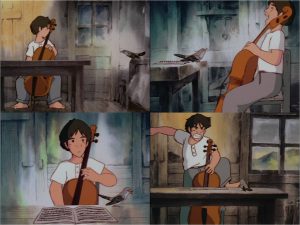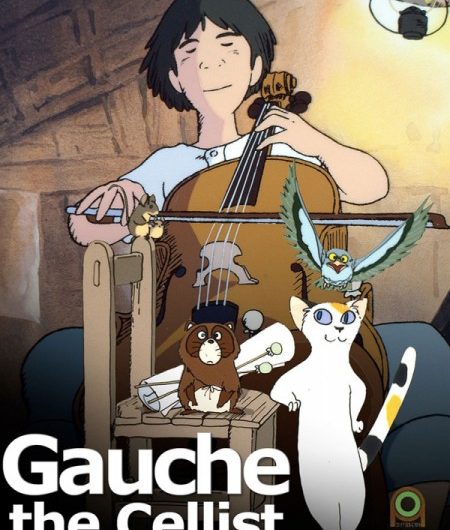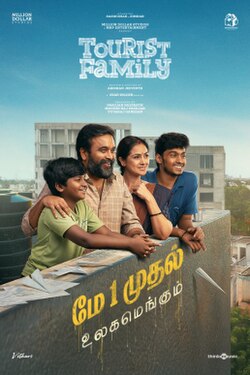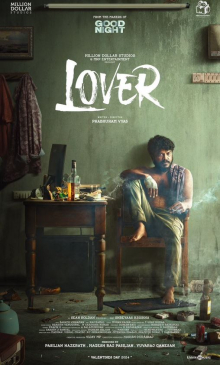I have always been attracted to Japanese animations. Not the dark, weird manga movies (sorry manga fans!) where teenagers are Soul Reapers, search for ways to bring their dead mother back to life or gains powers to kill people if he knows their faces or names. I love the Studio Ghibli type of movies where magic mingles freely with realism to create a blend that’s irresistibly fascinating. Incidentally, the movie that I am talking about in this post, Gauche the Cellist, was written and directed by Isao Takahata, who is the co-founder of Studio Ghibli along with Hayao Miyazaki.
Set in 1920s rural Japan, Gauche the Cellist (Sero Hiki no Gōshu) revolves around one event in the life of its titular character. Gauche is part of an orchestra, which is hurriedly preparing for a performance of Beethoven’s Pastoral Symphony coming up in 10 days. The conductor is a grumpy perfectionist who puts Gauche on the spot constantly for not being in tune or for not keeping time. After one particularly bad session, Gauche is practising at home with Beethoven’s photo watching over him when he is visited by a cat that asks him to play Schumann’s Traumerei. Annoyed at being interrupted, Gauche tries to shoo the cat away. But the cat insists, and Gauche gives in. In the next three nights, he is visited by a cuckoo, a raccoon, and lastly by a mouse and her ill son. All of them talk to Gauche, who at first is dismissive but grudgingly obliges their requests. In the end, Gauche and his orchestra give a superlative performance ending with roaring demands for encores.
 I adored the movie. It is enchanting in its portrayal of Gauche, a proud musician who eventually is humbled by creatures smaller than him. Where he thinks he is teaching, he is being taught. Where he thinks he is wasting his time by entertaining the animals’ requests, he is unwittingly gaining more mastery over his music. And the music! We are treated to some beautiful pieces from Beethoven and Schumann, woven in artfully into the film’s tapestry. Schumann’s Traumerei, one of my favourite pieces, flows out mellifluously for a few moments as does The Merry Master of a Coach Station. The music is a tangible presence, almost another character on its own, which enhances the story. Similar to the brilliant artwork by Shunji Saida.The watercolour painting that is the movie, is rich in its play of light and shade and evocating a surreal atmosphere that is so intrinsic to magical realism. It also helps in accentuating the important theme of nature being the heart of life. Reminiscent of many Ghibli movies that are set in the countryside, Gauche lives in a small hut, grows his own vegetables, and is surrounded by nature and its residents. There is perfect harmony in this peaceful world where nature and man are one, a fact that is brought out through the fine enmeshing of art and music.
I adored the movie. It is enchanting in its portrayal of Gauche, a proud musician who eventually is humbled by creatures smaller than him. Where he thinks he is teaching, he is being taught. Where he thinks he is wasting his time by entertaining the animals’ requests, he is unwittingly gaining more mastery over his music. And the music! We are treated to some beautiful pieces from Beethoven and Schumann, woven in artfully into the film’s tapestry. Schumann’s Traumerei, one of my favourite pieces, flows out mellifluously for a few moments as does The Merry Master of a Coach Station. The music is a tangible presence, almost another character on its own, which enhances the story. Similar to the brilliant artwork by Shunji Saida.The watercolour painting that is the movie, is rich in its play of light and shade and evocating a surreal atmosphere that is so intrinsic to magical realism. It also helps in accentuating the important theme of nature being the heart of life. Reminiscent of many Ghibli movies that are set in the countryside, Gauche lives in a small hut, grows his own vegetables, and is surrounded by nature and its residents. There is perfect harmony in this peaceful world where nature and man are one, a fact that is brought out through the fine enmeshing of art and music.
Gauche the Cellist is based on the short story by early 20th-century writer and poet Kenji Miyazawa. Some of his other short stories like Kaze no Matasaburo and The Night of Taneyamagahara have also been adapted to the big screen. If they are anything like Gauche’s story, I can’t wait to be transported to a different world.
Rating: 5/5
*Main image credit: Phimmoi
**Second image below credit: pennypicayune



